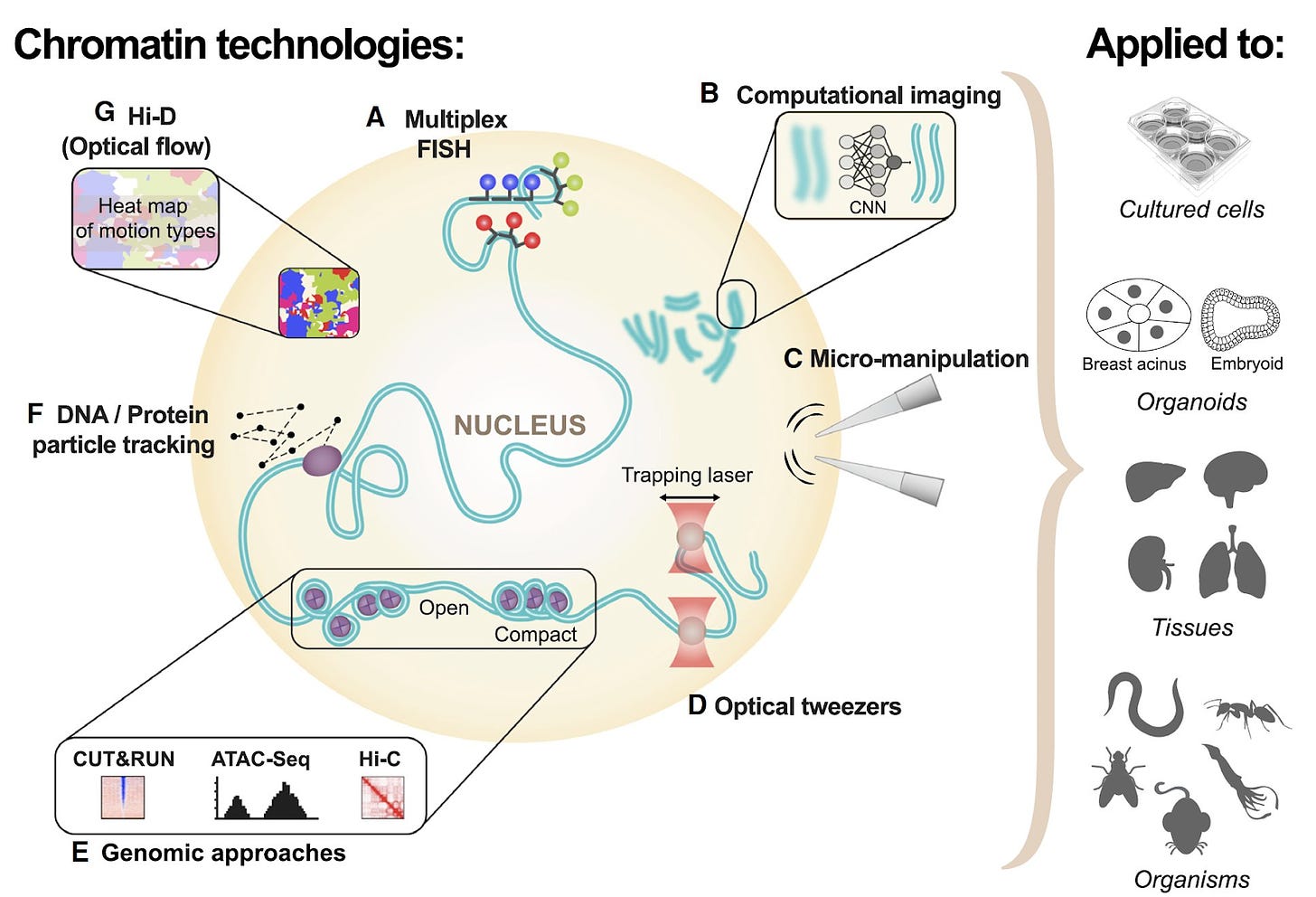More well thought out work can be found at — https://axial.substack.com/
Axial partners with great founders and inventors. We invest in early-stage life sciences companies often when they are no more than an idea. We are fanatical about helping the rare inventor who is compelled to build their own enduring business. If you or someone you know has a great idea or company in life sciences, Axial would be excited to get to know you and possibly invest in your vision and company . We are excited to be in business with you - email us at info@axialvc.com
Observations #23
A set of ideas and observations from a week’s worth of work analyzing businesses and technologies.
Nuclear technologies
The nucleus and its contents are entering a golden age for discovery. Everything from the 3D genome, to transcription factor (TF) dynamics, and beyond, are being characterized. This will flow into transformative medicines to control gene expression and treat a wide-range of diseases from cancer (via epigenetics) and aging (genome stability).
What tools are there to characterize things like chromatin, DNA packaging, and TF binding? They span across microscopy to physical tools and genomic/single-cell methods:
Genomics-based tools
HiC/3C/many variants - to measure the 3D. Hi-C measures the number of interactions between a given loci and nearby 3D space. These sequencing-based tools have become more feasible as costs have gone down.
ATAC-seq - for chromatin accessibility
There are a large set of immunoprecipitation tools to measure chromatin-protein interactions
Imaging
Multiplex FISH - determine chromosome structure/organization in living cells. This tool is very useful to physically probe certain regions of the genome. Work is being done right now to trace entire chromosomes.
PALM/STORM - measure real-time motion in the nucleus and single-particle tracking within the nucleus
Machine learning for image analysis is having a major impact on both these methods
Physical tools
Optical tweezers - using lasers to physically manipulate chromatin and other large structures. Useful to study chromatin in vivo.
Micromanipulation - toolkit to measure macro features like the force and elasticity that are being put on the nucleus
Which businesses are bringing these technologies to particular diseases or models to develop transformative medicines?

Clover Therapeutics: health insurance and drug development under one roof
Clover Health is a software-enabled Medicare Advantage PPO/HMO. They’ve built a good business in a competitive space. However, they have been working on a unique project to couple their insurance business with a drug development one focused on aging and chronic disease - https://www.cloverhealth.com/en/about-us/press/clover-health-launches-clover-therapeutics-and-genentech-partner: Clover Therapeutics.
What are the bringing an healthcare insurance company and drug development company under one roof?:
Long-term relationships with patients enabling more access to their records
Combining molecular data with clinical data. Then using genomics to discover new drug targets and maybe validate them too.
Unique access to patients drives biopharma partnerships
Ultimately, creating a patient-driven therapeutics company
The CSO of Clover Therapeutics wrote up a nice overview of their technical approach: https://medium.com/clover-off-the-charts/leveraging-disease-complexity-and-patient-diversity-for-drug-discovery-d402b9e52c0
This gambit by Clover shows that insurers focused on health outcomes, not just premiums will need to develop a wide range of products from new medicines to screening and adherence tools to new forms of patient care. Appropriately, Clover’s insurance business is strongly aligned with increasing the longevity and healthspan of their members. I could see more health insurers globally starting or investing directly in new drug and diagnostic companies and pouring more capital in aging drug development.
In Search of Greatness
I recently watched a great documentary: In Search of Greatness - https://www.imdb.com/title/tt8236398/ A common motif of individuals like Jerry Rice, Michael Jordan, and Wayne Gretzky is their ability to focus on what they are the best at and measure themselves. The key quote that stuck with me was: “Measure something because it's important, don’t make something important because you can measure it.”

Privatization of clinical pipelines
As more capital enters life sciences, will companies stay private for longer? With the slew of IPOs that doesn’t seem to be the case. And most biotech companies are VC-driven so are set up to get liquidity. However, are their advantages for a clinical-stage company to stay private? One I can think of is minimizing the volatility of the share price to have a stable cost of equity capital. In public markets, a company with a strong pipeline with say a lead phase 2 asset can have its market cap go down over 50% for something unrelated to the business or clinical progress.



